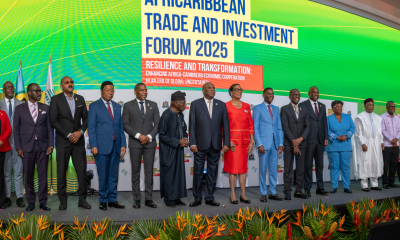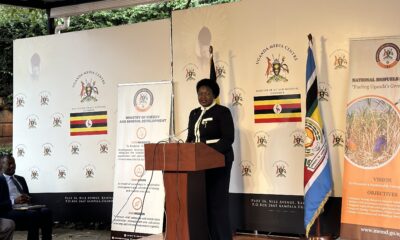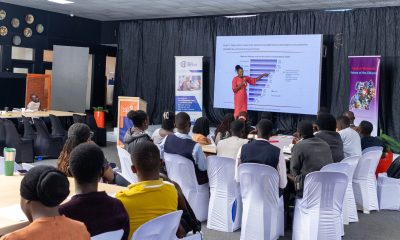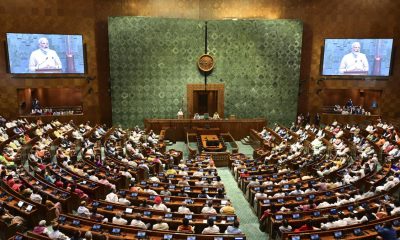Analysis
Africa’s new development ‘trigger’ unwrapped

Dr. Jonas Chianu, the TAAT Africa Coordinator speaking at the launch of the Maize Compact in Kampala
By then, Corn Products were importing maize from South Africa, but Uganda’s plentiful maize harvest during that year attracted the attention of the company with the view to source maize from Uganda. Sadly, Tumushabe and associates failed to meet the expectations of the Kenyan company, particularly about quality, timeliness and consistence.
A number of obstacles conspired to force Tumushabe and his associates in Commercial Farms to abandon the deal.
“Transporting maize by road would make ours more expensive compared to that imported by ship and rail from South Africa. The only option we had, if we were to stay competitive, would be railway. Unfortunately, rail transport at the time was unreliable.”
And that wasn’t all, he added: “The absence of standards in industry undermined the quality of maize. We encountered high levels of contamination especially with Aflatoxins which we observed came at the farm level.”
“Thirdly,” Tumushabe noted: “Our open borders ensured that we would still face competition from individuals who were exporting maize to Kenya without any restrictions.”
Tumushabe made the recollection during a meeting of stakeholders engaged in the maize value chain from across Uganda, who were convened by the National Agricultural Research Organisation (NARO) in collaboration with the African Agricultural Technology Foundation (AATF), to strengthen collaboration towards increased productivity of maize in the country. With support from the African Development Bank, the meeting sought to build partnerships that would help to increase the productivity of maize by sharing information on obstacles and opportunities so as to contribute to higher yields.
Tumushabe’s predicament and indeed that of millions of maize farmers across Uganda, was the focus of the discussion as participants sought solutions to worsening dollar-value of maize and other crops which have conspired to keep Africa in poverty.
The meeting was also used as an opportunity to launch a new drive code-named TAAT, short for Technologies for Africa’s Agricultural Transformation. Conceived by the African Development Bank (AfDB), as one the pillars of its Feed the Future strategy, TAAT seeks to promote the adoption modern technologies ranging from more resilient seeds, to maize driers and processors to trigger increased productivity of food.
A strategic option no government can ignore
For Tumushabe and indeed for a number of participants at the event, the government’s critical role in the development of agriculture in general and the maize value chain in particular, cannot be overemphasized. Not only does the sector help to guarantee food security, the basic requirement for a country’s security, it also helps to provide employment for majority of the population.
From setting standards on seeds, to the way farmers make choices on what to plant and handle food crops during and after harvest, to the way the yield is processed and exported, the government plays a fundamental role in opening up markets for farmers.
The liberalisation policy in Uganda that saw the government abandon the agriculture business, has greatly undermined the development of the value chain for maize, according to Asaph Niwagira, an official from the African Development Bank, Uganda Office.
Niwagira argued that farmers are rational beings who want to make money when they sense an opportunity. However, he said, absence of stable markets for maize and other crops, have become disincentives for investments into agriculture, particularly at the industrialisation level.
He was supported by Dr. Emmanuel Okogbenin, the Chief Technical Officer at AATF, who argued that when farmers do not have an assured market, productivity will always be irregular and generally low.
Most importantly, perhaps, Okogbenin argued, that the absence of modern technologies at different levels of production, greatly limits the market options for maize and other produce.

The TAAT team pose for a photo at the launch of the Maize compact
“The challenge with Africa remains the export of raw and unprocessed produce. We can make a lot more money by exporting value-added products such as starch, which commands a higher value,” said Okogbenin.
Dr. Grace Abalo, a maize breeder at Namulonge research station and the TAAT focal point person in Uganda, there is need for a debate among stakeholders about policies that can help industrialists such as beer makers to embrace the use of maize as the key ingredient in beer production instead of barley.
The current maize glut in the country, which has seen prices fall to as low as UGX150 per kilo, helped to focus the minds of participants, and perhaps cemented the sense of determination for transforming maize production from subsistence to commercial, technologically-driven enterprise.
“This is a unique opportunity for Africa, one that can truly turnaround African Agriculture and indeed the lives of millions of people on the continent who depend on agriculture,” said Dr. Okogbenin. He urged Ugandan farmers, seed producers to embrace biotechnology as one of the many tools in the box that can help to increase productivity.
In fact, according to Dr. Jonas Chianu, the AfDB TAAT Coordinator in Africa, today Africa has much advanced technology compared to what Latin America and Asia had in the 1970s when they launched the green revolution that sparked their economic transformation.
Dr. Chianu argued that what Africa needs more now is a mindset shift as well as greater coordination among the different stakeholders in order to make value chains to work.
The opportunities go beyond the possibility for stakeholders to tap into the more than US$700 million that AfDB and other funding bodies such as the World Bank have pledged to put into the project. As Dr. Chianu observed, AfDB has assembled experts to support stakeholders with capacity building, policy support, soil fertility improvement as well as mainstream the youth and women to engage in agriculture.
Besides the focus on maize, the TAAT initiative is targeting to leverage modern technology to increase productivity in rice, cassava, orange-fleshed sweet potatoes, iron beans, poultry, fish, goats and sheep as well as vegetables.
Key players in the value chains of those agricultural enterprises include government, seed companies, farmers, grain aggregators and processors and industrialists who use the commodities as raw materials.
The sense of urgency, according to Dr. Chianu, stems from the fact that despite Africa’s huge agricultural potential, it’s expenditure on imported food is rising at an alarming rate.
“Africa spends US$35billion on food every year. And if that is not bad enough, 160m Africans are malnourished with 2 million of them severely malnourished,” said Chianu.
He warned that if Africa does not sort out its agriculture, the hemorrhage of foreign exchange spent on food alone will spike to US$125billion by 2035.
“The sad bit about all this is that Africa is the region with the highest number unemployed youth. But importing food means that we are importing poverty by exporting jobs,” he added.
Under its Feed Africa strategy, Chianu observed, the African Development Bank intends to reverse the trend in spending on food and perhaps go beyond food to tap into the far more lucrative market surrounding the supply of value-added inputs in industries like pharmaceutical companies that use agro-bassed products as raw materials.
The discussion about transforming the agricultural sector was however dampened by the apparent lack of commitment by the Ugandan government to make value chains work.
The endless promises to support the reconstruction of maize storage facilities which would help government to effectively set a bench-mark price, was cited as one of the reasons for the sharp movements in the price of maize and indeed other agricultural products.
Tax policies such as the one recently imposed on semi-refined beer such as Chibuku, was cited as a disincentive for industrialists to use maize for beer making.
Some participants also cited the government’s reluctance to implement its own plans such as the Plan for Modernisation of Agriculture, in favour of politically-convenient alternatives like distribution of seeds, and promotion of SACCOs, as a threat to TAAT.
Players in the meeting however expressed optimism that working together would help to solve some of the bottlenecks, but also force the government to face the realities about the challenges arising from ignoring agriculture.
The biggest warning about inaction, came from Okogbenin, who noted that if Uganda does not make reforms now, it will lose its comparative advantage as a food basket of the region.
The reality that maize produced in South Africa can be more competitive compared to that produced in Kapchorwa located next door to Kenya, was an all too clear sign the Ugandan government cannot afford to ignore.
Comments


























